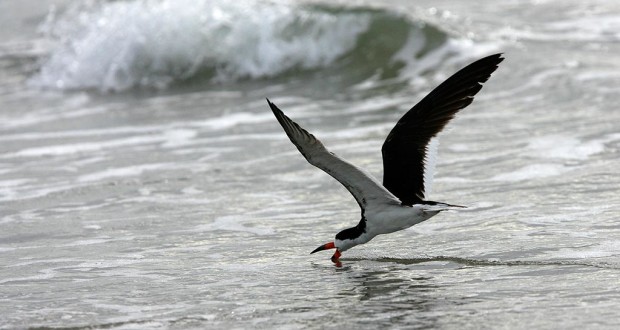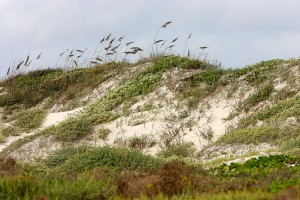The varied terrain of the park supports diverse wildlife, including more than 380 resident and migratory bird species. Along with much of the Texas coast, the park is a way station along the Central Flyway. Black Skimmers cut through the shallows in search of small fish. Terns, pelicans and gulls soar over the surf. Egrets and herons wade through prairie ponds and calm tidal flats. Myriad shorebirds plumb the sand and mud on both sides of the island for shellfish and crustaceans. Ghost crabs scurry along the beach near sunrise and sunset, spotted ground squirrels dart among the grassy dunes, and coyotes and jackrabbits trace paths across the prairie.
But sea turtles are the stars of the show on Padre Island. A modest number of Green and Loggerhead turtles nest along the coast, but the endangered Kemp’s Ridley sea turtle arrives in waves. In 2013, the park tallied 11 Green and 12 Loggerhead nests, but 86 Kemp’s nests through early August. Coming across a turtle making its way to the beach or back into the sea is a relatively uncommon sight, but the park conducts several public releases of sea turtle hatchlings between June and August. To watch them scramble into the water, call the hotline at (361) 949-7163 for the next release date.
If you want to drive on the beach, there are two access roads – one just north of the entrance station and the other at the end of the main park road. From the south beach entrance you can seemingly drive forever, but after about five miles the sand gets softer and the tides crawl higher up the beach, calling for four-wheel drive and extra caution. The park’s south beach ends after 60 miles of sand at the Mansfield Channel.
Separating the north and south beaches is Malaquite Beach, which runs most of the length of the developed area of the park and is closed to both beachfront camping and vehicle traffic. You can reach it from the parking lots at the end of either beach road or by strolling down the boardwalk from the visitors center. Early morning, before most visitors arrive, shorebirds and other coastal wildlife here are much more active, and your only encounters will be with a few odd beachcomers and fisherman. Later in the day, the park’s rangers offer short talks and walks along the beach that introduce you to the park’s natural and cultural history. During the migratory season between October and April, volunteers give more extended birding tours.
The place to collect shells – provided you have the right vehicle – is further down the south beach where the terrain is less picked over. Little Shell Beach – about 10 miles down – and Big Shell Beach – about 20 miles down, have higher concentrations of collectibles, especially after a big storm.
While the beaches get most of the attention, the middle of the island teems with flora and fauna. The paved Grasslands Nature Trail winds less than a mile through the coastal prairie just south of the entrance station and offers a great introduction. Lizards dart across the trail, raptors often soar above and on a recent walk a couple of coyotes wandered across my path.
To get to the bay side of the park, make the turnoff to Bird Island Basin. The area is a sometimes busy launching point for fisherman, boaters, kayakers and wind-surfers and requires an additional $5 access fee if you’re going to spend any time there. But it’s a great birdwatching site, and the birds seem to have grown accustomed to the activity. On a recent visit, I crept to within a few feet of a Great Blue Heron perched on a piling and a Long-billed Curlew wading along the shore, both of which appeared to ignore me completely.
REFUGE GALLERY











You must be logged in to post a comment.